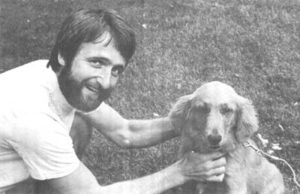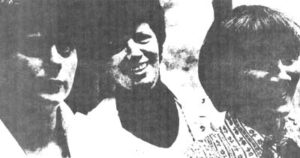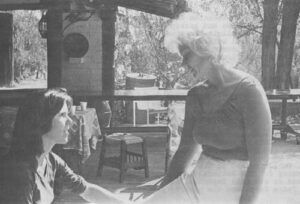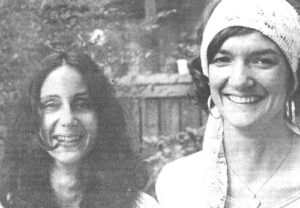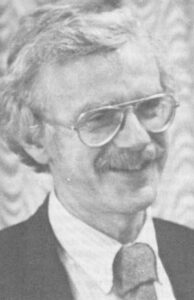“How many people practice self-care in the United States anyway?” the news re-writeman asked me. He had a copy of my first newsletter introducing the philosophy on self-care and he wanted a solid figure to nail it down for his lead sentence.
I was disappointing. I didn’t know and could only reply that I had been told about 70 per cent of medical care in the country was self-care.
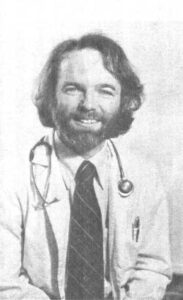
Next time he calls I’ll give Tom Ferguson’s answer: “All of them, whether they realize it or not.”
Ferguson, 34, editor of Medical Self-Care, a magazine he created and publishes at Inverness, Calif., is a dream for someone like me researching this relatively new field.
He explained that the reason he could say all Americans practice self-care is that they brush their teeth and are starting to pay attention to proper ways to brush. They decide when to go to the doctor and which doctor to go to and that is self-care. They also decide which patent medicine or non-prescription drug to take which is self-care or medical consumerism, a cousin of self-care.
Ferguson is the first person I have talked with to give clear distinctions between holistic health, traditional medicine and self-care. He forms a chart like this.

Ferguson explained one can plot any kind of treatment on the chart. Take a gall bladder operation done by a surgeon. Well, that would go in the upper right and would be expert/traditional.
A consumer taking his or her own blood pressure would be lower right: self-care mixed with traditional. A trip to the chiropractor would be upper left: expert/holistic.
And finally if you do yoga for a sore neck by yourself that would be lower left part of the chart: holistic/self-care.
He defines holistic health as approaches to health other than those used by traditional medical doctors. Holism centers flourish in California. It is easier to define them by what they are not than to list the specifics ranging from chiropractic and auto-hypnosis to naturopathies, herbalism and acupuncture.
Traditional allopathic medicine is defined as the kind taught in the country’s medical schools. Ferguson said, “Traditional medicine has three bullets in its treatment gun–drugs, surgery and psychotherapy.”
Ferguson said that in the beginning of his studies he saw the areas of holism, self-care and traditional medicine close together but “now I am finding them more far apart.”
“Self-care and holistic health are in different dimensions. They are neither the same nor are they opposites. The important criterion is that holistic is not traditional. Some tend to equate holistic with self-care when they are not the same at all,” said Ferguson.
He maintained that if that point could be understood, a lot of physicians would be for self-care and would call it simply patient education. He said that holism scares a lot of people and that they are not ready for it. For example, his parents’ neighbors in Oregon are just beginning to accept yoga, he said.
Ferguson defines self-care as taking responsibility for one’s own health as opposed to giving up that responsibility to a doctor and regarding it as the doctor’s problem.
“A pattern that I have seen is that someone will go to a doctor in the beginning of an illness. The doctor tells them to gargle and now they put the doctor in charge,” Ferguson said.
“This giving up of responsibility has a big part to play in malpractice insurance. In a way the philosophy is to turn out more mechanics (doctors) to fix cars (patients).
“Most of self-care is driver education with medical consumerism along side it using those mechanics more effectively,” he said. Sixty to seventy per cent of medical care isn’t the brain surgery variety but more likely smaller problems to which self-care can contribute greatly.
Ferguson felt that humanistic medicine was working toward training doctors to work better with patients and thus was complementary to self-care. I talked to Ferguson in a telephone interview during which he told me of a Western Self-Care Workshop in Sun Valley, Idaho, Oct. 5-7. He and Dr. Keith Sehnert (PSW-3) are main speakers. The conference is sponsored by Healthwise, Inc., a fairly new group which has a loose-leaf textbook and a set of ten video tapes for use by any medical professional to teach pre-packaged self-care. Ferguson will be bringing his video of 2nd and 3rd graders studying self-care in New Haven, Conn. Each child got stethoscopes for $2 to $5 and listened to one another’s hearts before and after running around the school building. They also listened to toes wiggling inside shoes, their intestines and the radiator making hot water. They wound up the class with a field trip to a veterinarian. Most fascinating to the children was the demonstration of dog and cat x-rays.
Ferguson expects to receive his M.D. degree from Yale University School of Medicine next June when he will take another year and do the magazine. He stresses the subtitle of the magazine: Access to Medical Tools, an approach he derives from the Whole Earth Catalogue Providing people with tools and trade secrets.” For the last nine months he has been medical editor of CoEvolution Quarterly which grew out of the Whole Earth Catalogue.
His first issue of Medical Self-Care has a section Your Black Bag with information on where to buy stethoscopes, blood pressure cuffs, a vaginal speculum, and a reflex hammer.
Ferguson says: “People in this country are not well-trained to deal with illness. A lot of money gets spent to treat people at the very terminal stages of avoidable illnesses and very little attention is paid to avoiding them in the first place.”
He hopes to turn the situation around by making the consumer “the first level of a total health care team where there would be appropriate skills assigned to the health consumer. He would work somewhere between that of physician’s assistant or a nurse and someone who knows nothing.”
The magazine reviews books as medical tools by a succinct paragraph or two after which it amply quotes portions of the books. In his first issue Ferguson notes a good way to find a doctor is to call an intern between 8 and 10 a.m. at the hospital and ask him to give you a couple of names. Ferguson adds:
“Interns see doctors at their best and their worst, and they know who the good ones are. They’ll also be so flattered that you’ll get a good recommendation. Nobody ever asks an intern anything.”
Ferguson still has his internship and residency, possibly in family practice, ahead of him. His few paragraphs on “working with doctors” I quote:
“Doctors are treated very curiously in this culture. They’re loved and respected and feared and hated. They’re overworked, overpaid and not allowed to make mistakes.
“Doctors have been treated as gods for a long time. That’s starting to change now, and it’s just as hard for doctors to adjust to the change as it is for patients.”
“Laypeople and doctors have to help each other co-evolve into new roles in which the layperson can know a little more medicine, and the doctor can be a little more human.”
Sample copies of the magazine are available for $2 and yearly subscriptions for $7 by writing P. 0. Box 718, Inverness, CA 94937. The magazine has been packed with self-care information. I particularly like that it has a section for kids for I believe kids are where the action is when it comes to teaching self-care.
Unfortunately most school health classes discourage self-care, according to Levin, Katz, and Holst: Self-Care; Lay Initiatives in Health: “School health education, where available, has by and large perpetuated a view of health care which suppresses or severely limits the growth of values and beliefs that the individual is competent as the primary source of health maintenance. Health ‘facts’ are presented to children as secure and immutable, health professionals as possessing skills fixed and demarcated from those available to laypersons. ‘Folk medicine’ or home remedies and indigenous health customs are often denigrated as quaint, ineffective, and sometimes dangerous.”
That is a long way from Ferguson’s school children learning by exploring with their stethoscopes.
Under the Hands of a Chiropractor
I was face up on the adjustment table dressed only in my briefs, while Chiropractor Bruce Hedendal stood over my head. He slipped on separate latex gloves over his thumb and forefinger while he explained he was going to do a cranial adjustment. “It will release blockages from the very day you were born,” he said.
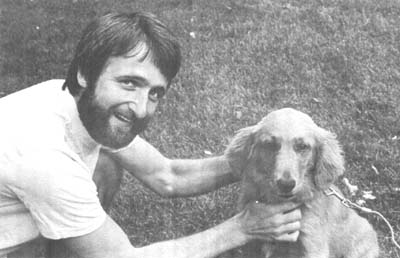
In a moment he was under my cheekbone, pushing against my palate, probing the bone where the top teeth fit. The pain came when he began pushing deep against my jaw. I panted like a LaMaze mother in labor to absorb the pain. I wiggled my feet and hands and watered at the eyes but the pain kept coming. “I was realigning the jaw with the temporal plate bones of the skull and opening up the cranial sutures” was the way he explained it later. The left side, however, hurt hardly at all. “There is speculation that a tight right side indicates being linked to complexes associated with the mother.”
He concluded the adjustment with a meditation in which his powerful fingers pressed against the back of my skull. He asked me to focus my healing power on one part of the body and to report what colors I saw. It was the most pleasant time in 11 sessions. The pain had gone and the inside of my face felt open and full of light, somehow sweet light, orange and sometimes blue.
I meditated on my thyroid because it was after several sessions that he pronounced me hypothyroid or underactive in that gland. I awoke from the meditation and went to my car and couldn’t bring myself to drive away. That same pleasurable feeling under my cheekbones came back as soon as I sat down, so I closed my eyes and drowsed in an orange light. When I reported this to Dr. Hedendal the next day he said I was in deep alpha. He said the cranial work releases old blockages and one never knew what the effect would be. “We never have full health potential until these blockages are removed so what we consider normal really isn’t. A lot of childhood diseases can be attributed to these blockages,” he said.
He said that often spinal corrections won’t last unless the primary blockage in the cranium is aligned.
Dr. Hedendal plans to attend an annual cranial technique seminar in Omaha. One in 40 chiropractors use it but more are learning, he said. It is traditional when I tell friends I am seeing a chiropractor that they will ask, “Something the matter with your back?” They envision strong thumbs pushing in a subluxated vertebra when in fact my chiropractor sticks his fingers down my throat and gives me dietary supplements for my thyroid including thytrophin, an extract of beef thyroid tissue.
Getting my spine and cranium aligned is all part of what I would call wellness treatment and getting more well or more healthy. I feel I have much more energy and am less drowsy.
Dr. Hedendal, who is 29, is into natural foods (his wife makes him carrot juice for lunch), distilled water, jogging eight miles a day, and following Meher Baba.
He said that any one of several things he did to me could be responsible for the changes. As to what differences he noticed in me since he began two months ago, he said, “Your aura. It was leaking, leaking energy around your head before. Now it is centered, and the energy is contained.”
I told him I didn’t realize he could see auras and asked what color mine was. He paused. “You can’t tell. It’s constantly changing.”
So most of my friends may not realize it, but at last I have gotten rid of my leaky aura. No telling what could happen with one of those.
New-Age Coach Urges Hair Sample Test
Part of self-care by my definition is reaching out to the right experts be they medical doctors or holistic practitioners to learn to get healthier. Health is more than the absence of disease, it is a continuing project we never stop working on. The reason I went to the chiropractor was for better health, and I went before I was saddled with back problems and deep and heavy pain.

(New Age Photo)
I have chosen a coach in these matters–a lifestyle fitness coach as she calls herself–and she is a platinum blonde Dane with a bubbling laugh named Dyveke Spino from Mill Valley, California. She is a concert pianist, ski instructor, tennis pro, long distance jogger and swimmer and co-founder of the Esalen Sports Center on Big Sur at 45. She is also a trainer for the U.S. Olympic rugby team. I met her at a holistic conference in Boston where she had 500 to 600 participants skipping and galloping, jogging and laughing around the auditorium. I was immediately attracted by her enthusiasm, spirit and energy. She wore running shoes and leotards. Later I signed on for a day-long jogging workshop she gave followed by an individual consultation. We talked about swimming, jogging, playing the guitar (I used to play and haven’t for a while), writing and yoga as a training regime for me. We talked about my life and my work, too, and the conversation ranged beyond the athletic. Towards the end she said, “This is your healing summer. Remember, you are an athlete in training.” I felt really good that she had called me an athlete because I am 10 to 15 pounds overweight. There was obviously great hope for me, and she believed it. She added that at some point I should send her a hair sample because she had someone who could analyze it with computers and see if I were suffering from any toxic substances. She had just discovered she was a victim of aluminum poisoning, presumably from pots and pans. She had a hefty bunch of pills she was taking to detoxify herself from the metal.
The nice thing about Dyveke (pronounced Dur-ve-ka) is that I can always write or call her. It was she who helped me set up a jogging and swimming schedule. She is the first coach I’ve had since I left high school 22 years ago who cares about my training. Only difference is that her coaching includes suggesting acupuncture and Rolfing, a deep massage as practiced by Ida Rolf and her son to probe emotions stored in the body.
It was she who suggested I see the chiropractor. If I follow her recommendations and guidance I may have a full tour of the holistic health community having my hair tested one place and my saliva another and I don’t know what at a third. As I see it, it is an adventure and exploration in health that can serve as a good way to tell my story as my fellowship year progresses.
Hospitals Fight Planners in Bed Cuts
Getting money for prevention, health promotion and patient education to help people avoid going into hospitals is a goal of government health planners. Forty per cent of the $140 billion spent on health went to hospitals, the largest share. The other two large receivers of the health dollar were doctors and drugs. The theory is that if you can get hospitals to give up beds which require many dollars to maintain you can use that money for prevention. That is easier said than done.
When local planners north of Boston proposed cutting 400 acute care beds, the plan was bombed with hospital opposition at the plan’s first public meeting.
Hospital aid women came off like Joan of Arc defending their bastion. A local newspaper columnist discounted the whole idea with jokes that much money could be saved by “Do-It-Yourself Surgery” and bedpans that work only if you pay a quarter (“Pay Potties”). It was pretty low-grade humor, but it indicates the depth of feeling against government planning and against touching the hospital’s autonomy. One tall blonde woman, president of the local hospital aid association which could be closed outright, was furious and called for everyone in the overheated room to band together and fight the planners. Thirty spoke in opposition that first hearing night. I heard only two persons speak for the proposed cutbacks, a woman who worked with a women’s self-help agency and a doctor who is president of a large hospital staff who said everyone knew that facilities are duplicated. “We are hearing too much negative and not enough positive,” he said.
The planning agency, the North Shore Health Planning Council, covers 27 communities north of Boston from historic Lynn, Marblehead and Salem to Gloucester and Rockport, Mass. Leslie Lipkind is director of planning for the agency and throughout the meeting was sitting in his suit stretching his foot in low cut boots, rubbing his beard and looking uncomfortable as people cried out that the problem was caused by “the bureaucrats.”
Lipkind, 32, who has been three years with the agency, spoke with me the following afternoon. “We are spending money on a system geared toward curing. The system has technological knowledge to save some patients for a few months but with little effect on overall lifespans.”
“The new way is toward prevention and affecting lifestyles to have a long term effect. Right now demands are unlimited with the idea if you can save one life by getting a $500,000 CAT scanner it is worth it. A CAT scanner is a computerized x-ray technology for “seeing” inside the body and brain without cutting into it.
Lipkind estimated that by 1981, 10.2 per cent of the Gross National Product would go for medical care. He noted that 80 per cent of nursing home care is paid for by medicare and medicaid and the reason local communities can’t make decisions about their hospitals alone is because they, too, are supported by public money.
The problem is moving from a curative to a preventive system and determining what the long-term payoff is going to be, he said.
Lipkind said the hospitals in his region are unlikely to feel a cost savings from cutting beds if the North Shore is the only region to cut back. “If it is going to work it has to work across the whole state and nation.” “Furthemore,” he said, “the bed saving is nearly ten times as much if a whole hospital is closed than if a few beds are cut out of an existing hospital.”
“Beds represent service, tests, x-rays and lab services. That is what is skyrocketing costs,” he said. “There is a lot of PR and appeal to the emotions by the hospitals. Supply of beds creates its own demand.”
Some critics had predicted that if acute beds were cut back surgery waits such as for hernia operations would reach one to two years as they were claimed to be in England.
Lipkind said he didn’t know if there would be waits. He stressed that “We use hospitals simply because we are accustomed to using them.”
He pointed to the federal government with its pronouncements for prevention which is apparently unwilling to change a medicare rule which increases hospital use unnecessarily. The rule: to put someone on medicare for home care requires first that the person be put in a hospital for three days.
Lipkind said he was not surprised at the reaction he got at the meeting, only the intensity of it. “Hospitals have a vested interest he said. “The decision can’t be made town by town because the local towns don’t pay the cost. Not one hospital could exist without public money.”
Lipkind’s agency has a 30-member board of trustees with 250 consumers and providers as members. They serve on committees including the task force which studies the bed cuts. The agency has a network of sister health systems agencies similarly run throughout the country.
I am headed for Canada to explore that country’s prevention plan and how it tries to influence citizens’ lifestyles to maintain better health. The themes I have touched on in this four-part newsletter–selfcare, my own personal growth in health and government efforts to shift spending from acute care to prevention–are themes I will continue to investigate during my travels to Canada and around the United States.
Received in New York on September 6, 1977
©1977 Phil Weld, Jr.
Phil Weld, Jr. is an Alicia Patterson Foundation award winner on leave from the Lawrence Eagle-Tribune. His fellowship subject is the role of self-care in health: a look at prevention, patient education and patient power in the U.S. and Canada. This article may be published with credit to Mr. Weld as a Fellow of the Alicia Patterson Foundation and to the Lawrence Eagle-Tribune. The views expressed by the author in this newsletter are not necessarily the views of the Foundation.

